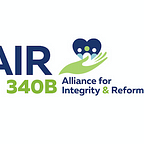GAO Raises Additional Concerns With 340B Contract Pharmacies and Hospitals
The 340B drug discount program — a vital safety-net program created to help millions of vulnerable or uninsured patients receive care — is no longer benefiting many of the patients it was meant to serve. That’s according to mounting findings from congressional investigations, independent economists, and government watchdogs. Two new studies released by the Government Accountability Office (GAO) add to these growing concerns, looking specifically at contract pharmacies and hospitals in the 340B program. GAO’s latest conclusions provide further evidence more must be done to fix the 340B program and bring it back to the original intent of helping patients.
Contract Pharmacies — Not Always Passing 340B Discount on to Patients
As a result of guidance issued by the Health Resources and Services Administration (HRSA) in 2010, 340B covered entities (which includes hospitals and federal grantees such as community health centers) can partner with an unlimited number of pharmacies to distribute medicines to patients. This has allowed for the broad participation and growth of for-profit, chain pharmacies in the 340B program, which has raised many questions regarding whether these contract pharmacy arrangements are in fact benefiting patients.
Today, some hospitals have more than 400 contract pharmacies. Previous watchdog reports have discovered hospitals contracting with pharmacies as far away as 100 miles. In June, GAO released a report examining the increasing role contract pharmacies are playing in the growth of 340B. Today, there are around 20,000 contract pharmacy arrangements with 340B covered entities compared to the only 1,300 contract pharmacy arrangements back in 2010.
GAO found two troubling patterns of behavior exhibited at these pharmacies: 1) A majority of 340B hospitals they surveyed do not pass the savings generated by 340B on to vulnerable or uninsured patients and 2) HRSA lacks the necessary information to provide adequate oversight of contract pharmacies.
Specifically, GAO surveyed 28 hospitals and found less than half provided 340B discounts to uninsured or vulnerable patients at some or all of their contract pharmacies. While some contract pharmacies at hospitals did provide a partial discount to patients, some of these contract pharmacies still forced uninsured or vulnerable patients to pay a higher price than the 340B discounted price the pharmacy paid for the same medication.
GAO also found hospitals are more likely to contract with large, for-profit pharmacies. CVS, Walgreens, Walmart, Rite-Aid, and Kroger make up 60 percent of 340B contract pharmacies, even though they are only 35 percent of all pharmacies nationwide. 340B was created to support non-profit entities yet for-profit pharmacies have found a way to take advantage of the program to pad their bottom lines at the expense of patients. Read the full report here.
Hospital Characteristics — Who is Benefiting?
In addition to their work examining contract pharmacies, GAO released a study in July that analyzed the characteristics of hospitals participating and not participating in the 340B program.
As we’ve mentioned before, one way private hospitals are eligible for the 340B program discounts is based on a statutory metric used by the Center for Medicare & Medicaid Services (CMS) to make payments to hospitals that treat many vulnerable inpatients. This disproportionate share hospital “DSH metric” is based on certain publicly insured patients treated as inpatients, yet there is a mismatch since the 340B program is an outpatient program meant to assist vulnerable or uninsured patients. Aside from this mismatch, GAO’s findings demonstrate several additional reasons why the DSH metric is an inappropriate metric for determining 340B hospital eligibility. For one, GAO found that from 2012 to 2016, Medicaid expansion enabled more hospitals to qualify for 340B through the DSH metric. Meaning, fewer patients were uninsured as a result of Medicaid expansion, so hospitals’ uncompensated care burden decreased, yet more hospitals qualified for the safety-net 340B program because of the DSH metric.
GAO also found that 340B DSH hospitals in Medicaid expansion states, on average, provided a lower amount of charity and uncompensated care compared to 340B DSH hospitals in non-expansion states. Increased growth in the 340B program should correlate with higher rates of charity care and uncompensated care at such hospitals, but the data and evidence clearly paint a different picture.
The creation of the 340B program was meant to help patients receive affordable medicines through certain safety-net facilities, but at this point, we are left with an important question: Who is benefiting? These two new GAO reports are a part of a broad chorus of evidence that the program must be fixed to help those it was meant to serve: Vulnerable patients. A collaborative spirit is needed to get the program back on track to fulfill its original purpose of providing care for those who need it most.
To learn more, visit: 340Breform.org.
